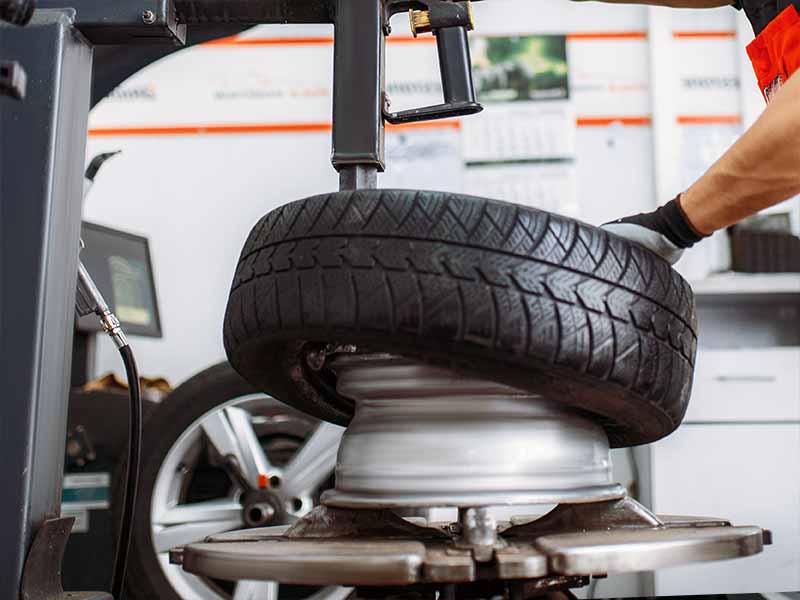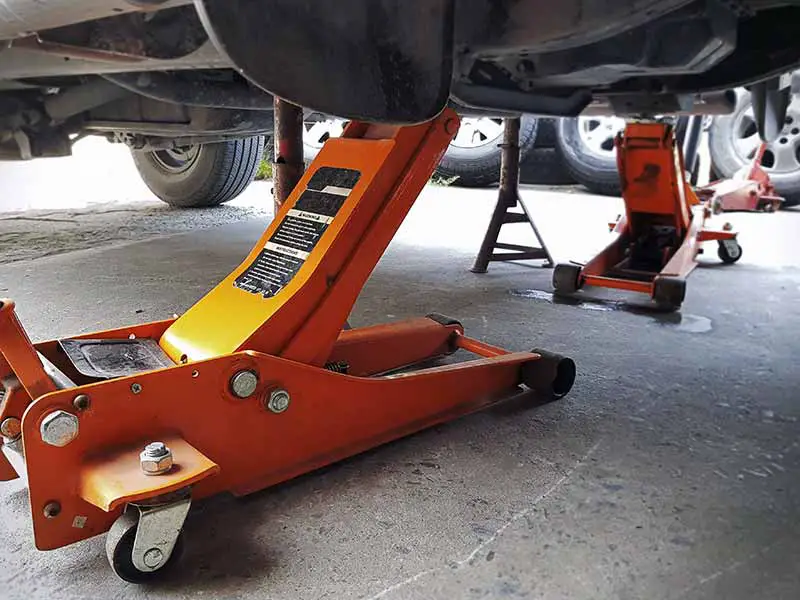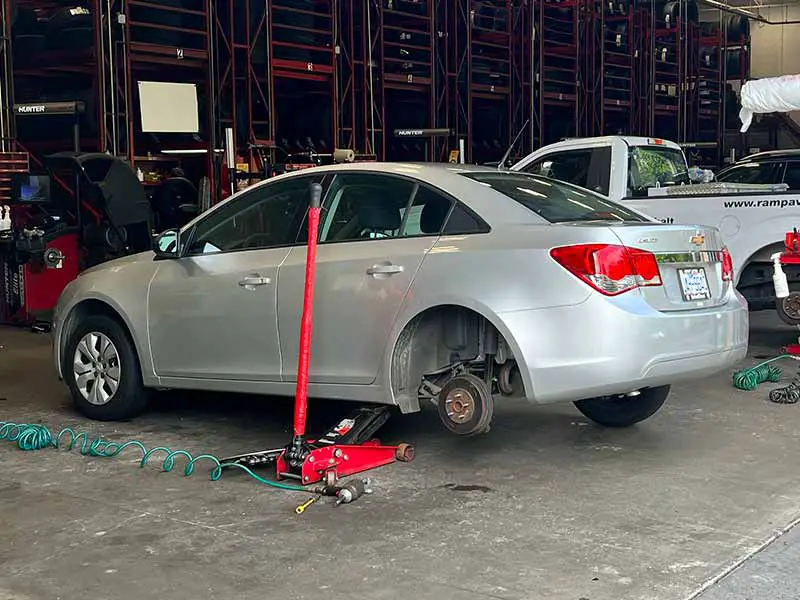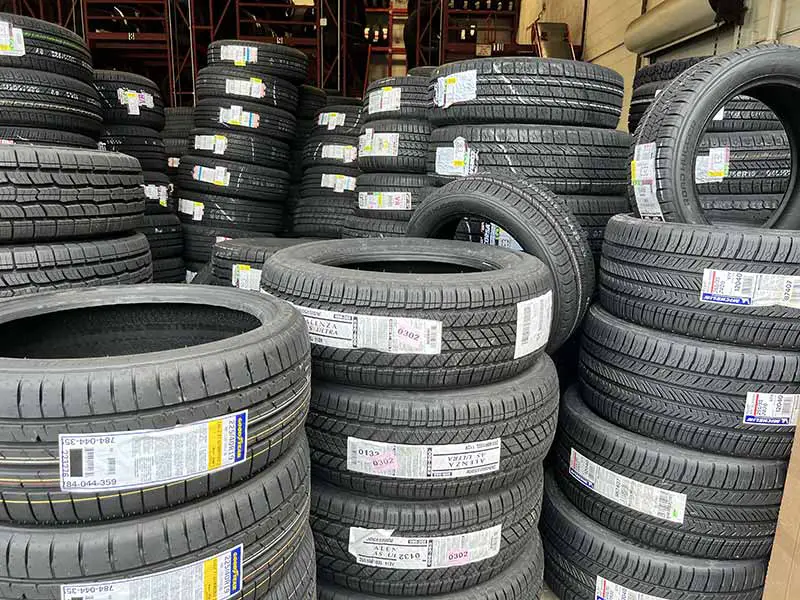Chances are you’re sitting in the waiting room at your local tire shop, or planning on being there very soon. You may need to purchase a set of four tires after experiencing a flat tire. Or maybe you’re swapping your summer tires to winter tires as the first snowflake falls. Maybe you’re even planning to swap your tires yourself.
How Long Does It Take To Change 4 Tires?
Changing four tires at a professional shop typically takes between 45 minutes to an hour. However, if you’re doing it yourself, it might take anywhere from 20 minutes to an hour per tire, depending on experience and tools at hand.
In this article, you’ll learn how long tire installation by a professional mechanic takes as well as how long it should take you to change tires yourself. We’ll also cover the different factors that affect how long it will take to change your tires.
Let’s take a closer look.

Factors That Affect the Time to Change Tires
Changing tires might seem straightforward, but a few things can either speed up or slow down the process. Here’s a look at some of the major players.
Type of Vehicle
The kind of vehicle you drive can play a big part in the time it takes to swap out those tires.
- Passenger Cars: These are your everyday vehicles, like sedans and hatchbacks. Generally, they have standard-sized tires and are pretty straightforward to change.
- Trucks: Trucks, especially the bigger ones, come with larger, heavier tires. These might need special equipment or more muscle to handle, adding a bit more time to the process.
Number of Tires Being Changed
Seems obvious, right? But there’s more to it.
- Changing 2 Tires: If you’re only swapping out two tires, it might take less than half the time of changing all four. But remember, you need to ensure the new tires match the old ones in wear and type.
- Changing 4 Tires: The full monty! Changing all four tires ensures even wear and balance on the road. While it takes longer, it’s often worth the effort.
Skill Level
Whether you’re a newbie or a seasoned pro makes a difference!
- DIY (Do It Yourself): For those brave souls tackling a tire change on their own, expect a learning curve. The first time might take a bit longer as you get the hang of things. Don’t get discouraged, though! Practice makes perfect.
- Professionals: Mechanics and tire technicians do this day in and day out. They’ve got the process down to an art, often having special tools and machines that speed things up. It might cost a bit, but you’re paying for expertise and efficiency.
Environment & Conditions
- Garage vs. Roadside: Changing a tire in the comfort of a garage, with all tools within reach, is a smoother process compared to a roadside change in the rain.
- Weather: Rain, snow, and extreme temperatures can influence the time it takes. Cold weather can make tires and tools more challenging to handle, while rain can make the whole ordeal slippery.
Equipment & Preparation
Remember the saying, “A stitch in time saves nine”? Well, being prepared can save you loads of time!
- Having the Right Tools: Ensure you have all the necessary tools ready. Scrambling around looking for a lug wrench mid-change isn’t fun.
- Quality of Equipment: A rusty old jack might not be as cooperative as a well-maintained one.

Changing Tires by Yourself vs. Professional Help
Ever wondered if you should roll up your sleeves and tackle a tire change yourself or head to a pro? Let’s weigh the options.
DIY Tire Change
There’s a certain satisfaction in doing things yourself. And with the right tools and a bit of elbow grease, you can certainly change your own tires. Here’s a quick look at what’s involved:
Steps to Change a Tire:
- Safety First!: Always park on a flat surface, away from traffic. Use your parking brake.
- Ready Your Tools: Get out that lug wrench, jack, and, of course, the new or spare tire.
- Loosen the Lug Nuts: Before you lift the car, loosen (but don’t fully remove) the lug nuts.
- Lift the Car: Place the jack in the right spot (check your manual) and lift the car off the ground.
- Swap the Tires: Remove the old tire, put on the new or spare one, and hand-tighten the lug nuts.
- Lower the Car: Slowly lower your car. Once it’s securely on the ground, fully tighten the lug nuts in a crisscross pattern.
Time it Takes When You Do It Yourself:
- First-Timers: Your first tire change might take a little longer, perhaps 30-45 minutes per tire as you get familiar with the steps.
- Experienced DIYers: With experience, you could get this down to 15-20 minutes per tire. But always prioritize safety over speed.

Professional Tire Change
There’s no shame in heading to the experts! They’ve got experience, equipment, and often a cozy waiting room with coffee.
What Happens at a Pro Shop:
- Check-in: They’ll ask about your needs, maybe check your current tires, and guide you on choices if you’re buying new ones.
- Mounting & Balancing: Most shops will not just change the tires but also ensure they’re balanced, which means smoother rides and longer-lasting tires.
- Time Factor: At popular chains like Firestone, Walmart, and Discount Tire, the whole process can take anywhere from 45 minutes to a couple of hours, depending on how busy they are and what services you’re getting.
Advantages of Professional Help:
- Expertise: They’ve seen it all. Whether it’s an odd wear pattern or a tire that refuses to cooperate, they’ve got a solution.
- Equipment: Machines to lift your car, advanced tools for faster lug nut removal, and machines for balancing.
- Warranties & Guarantees: Many shops offer guarantees on their work, giving you peace of mind.

How Long at Different Shops?
Tire shops abound, from big-name chains to your local garage. But how long does each take? Let’s break down the time factor based on the most commonly searched places.
Firestone
A big player in the game, Firestone Complete Auto Care offers a comprehensive tire service.
- Booking: A scheduled appointment can save you wait time.
- Time Factor: Typically, for all four tires, expect anywhere from 45 minutes to 2 hours. It can vary based on the store’s busyness and your specific vehicle needs.
- Extra Services: They also offer tire rotation, alignment, and inspection. Remember, extra services might add to your wait time.
Walmart Auto Center
Everyone’s familiar with Walmart, but did you know they also have an auto center?
- Booking: They accept walk-ins, but appointments might reduce your wait.
- Time Factor: Changing four tires here can take around 1 to 2 hours. However, like all places, peak times might mean longer waits.
- Value Proposition: The beauty of Walmart is you can shop while you wait. So, if you’ve got a shopping list, it’s a win-win!
Discount Tire
Another significant contender in the tire world, Discount Tire promises speed and efficiency.
- Booking: They’re known for quick turnarounds, especially with appointments.
- Time Factor: On average, expect your four-tire change to take between 30 minutes to an hour. They pride themselves on swift service.
- Special Features: They often run promotions and price matches, so keep an eye out for deals!
Local Garage or Mom-and-Pop Shops
Your neighborhood garage might not have a big brand name, but they have charm and personalized service.
- Booking: Given they might have fewer bays, it’s always a good idea to call ahead.
- Time Factor: Generally, local shops might take 1 to 2 hours, depending on the workload and size of the shop.
- The Personal Touch: One big advantage is the relationship. They might remember your vehicle’s history and offer tailored advice.
Key Takeaways:
- Peak Times: Saturday mornings and weekday evenings can be busy. If possible, try for off-peak hours.
- Shop Around: If time is of the essence, call ahead and ask for estimates. You might be surprised at the variations.
- Quality Over Speed: While it’s great to get quick service, the quality of the tire change is paramount. Ensure the shop you choose has a good reputation.

How the Pros Change Tires at a Shop
Ever wondered what goes on behind the garage doors when you hand over your keys for a tire change? Professionals use a combination of specialized tools and honed skills to ensure a precise and efficient tire change. Let’s pull back the curtain and dive into the tools and processes professionals employ.
Tools Used by Professionals:
The right tools make all the difference. Here’s what you might find in a professional’s arsenal:
- Tire Changer Machine: Speeds up the removal and installation process.
- Computerized Wheel Balancer: Ensures even weight distribution around the new tire.
- Torque Wrench: Ensures lug nuts are tightened to exact specifications.
- Tire Pressure Monitoring System (TPMS) Reset Tool: Adjusts the vehicle’s tire pressure system when necessary.
- Jack and Jack Stands: To safely elevate the vehicle.
Step-by-Step Guide:
Changing tires in a shop isn’t just about speed; it’s about precision. Here’s what happens:
- Vehicle Assessment:
- Professionals first assess the overall condition of your tires and wheels. They might catch issues you weren’t aware of.
- Elevate the Vehicle:
- Using heavy-duty jacks, the car or truck is safely lifted off the ground.
- Remove the Old Tire:
- The lug nuts are removed using an impact wrench.
- The tire changer machine then unseats the tire from the rim.
- Install the New Tire:
- The new tire is mounted onto the rim with the tire changer machine, ensuring a snug fit.
- The tire and wheel assembly are then balanced using the computerized wheel balancer.
- Reattach the Wheel:
- The wheel is placed back on the vehicle’s hub.
- Lug nuts are hand-threaded first, then tightened with a torque wrench to the vehicle’s specifications. This ensures even pressure and reduces the risk of warping the brake rotor.
- TPMS and Final Checks:
- If the vehicle has a Tire Pressure Monitoring System, it’s reset or adjusted.
- Tire pressure is checked and adjusted to the vehicle’s specifications.
- A final inspection ensures everything is in order.
Why the Time Requirement?
While it might seem like a straightforward process, professionals prioritize precision over speed. They’re not only changing your tire; they’re ensuring every component interacts seamlessly. Balancing, for instance, can take a bit of time but is essential to prevent uneven wear and ensure a smooth ride.
Resources
Below are some links you may find helpful when learning about tires
- How long does it take to get new tires installed? – J.D. Power
- How long does it take to replace 4 tires? – Get Jerry
Final Thoughts
Changing a tire, whether done by professionals or as a DIY project, is a straightforward process when approached methodically. But beyond the simple act of replacing them, remember the importance of regular tire maintenance: checking pressure, rotating for even wear, ensuring proper alignment, and keeping an eye on tread depth. These practices not only prolong the life of your tires but enhance vehicle performance and, most crucially, safety.
Good luck and happy motoring.





